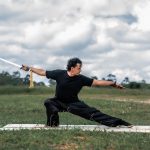Are you searching for the most effective martial art for self-defense? Look no further.
This article presents a comprehensive ranking of the 7 best martial arts for self-defense, offering detailed insights into their practicality, versatility, and proven effectiveness.
From grappling-based styles like MMA and Brazilian Jiu-Jitsu to striking-based arts such as Muay Thai and boxing, we explore the attributes that make each martial art highly effective in neutralizing opponents.
Discover the best options for self-defense and make informed decisions about your personal safety.
Key Takeaways
- BJJ is highly effective against all martial arts
- MMA incorporates a variety of martial art styles and is the fastest-growing combat sport in the world
- Wrestling focuses on takedowns and ground control and is effective for self-defense in close-quarters situations
- Muay Thai emphasizes punches, kicks, knees, and elbows and is effective for self-defense in stand-up fights
Grappling-Based Martial Arts
One highly effective option for self-defense is a grappling-based martial art. Grappling techniques for self-defense involve close-contact techniques such as throws, joint locks, and ground fighting.
Learning a grappling martial art provides numerous benefits for individuals seeking mastery in self-defense. Firstly, grappling techniques allow practitioners to gain control over an opponent, regardless of their size or strength. By utilizing leverage and technique, a smaller individual can effectively defend themselves against a larger attacker.
Additionally, grappling martial arts promote physical fitness, flexibility, and mental discipline. The rigorous training involved in grappling arts helps practitioners develop strength, agility, and endurance.
Moreover, learning grappling techniques enhances self-confidence and self-awareness, providing individuals with a sense of empowerment and the ability to handle potentially dangerous situations.
Striking-Based Martial Arts
Striking-based martial arts, such as Muay Thai and Boxing, are highly effective for self-defense due to their emphasis on powerful punches, kicks, and strikes. These martial arts provide a range of benefits for self-defense purposes, including:
- Muay Thai, known as the 'Art of Eight Limbs,' utilizes punches, kicks, knees, and elbows, making it a versatile striking art for any situation. Its techniques are designed to generate maximum power and efficiency.
- Boxing, with its focus on developing excellent striking skills, trains practitioners to throw punches with precision and speed. It emphasizes footwork, head movement, and defensive techniques to evade attacks.
To be effective in striking-based martial arts, mastering the techniques is crucial. This includes proper stance, timing, and body mechanics to generate power and accuracy in strikes. Techniques like the jab, cross, roundhouse kick, and knee strikes are fundamental in these martial arts.
Self-Defense Through Avoidance and De-Escalation
To effectively protect oneself, it is important to prioritize self-defense through avoidance and de-escalation techniques. Non-violent conflict resolution, situational awareness, and personal safety are key elements in this approach. By being aware of our surroundings and recognizing potential threats, we can often prevent confrontations before they escalate. Additionally, learning techniques to defuse tense situations and resolve conflicts peacefully can be invaluable in avoiding physical altercations. Here is a table highlighting some key strategies for self-defense through avoidance and de-escalation:
| Technique | Description | Benefits |
|---|---|---|
| Situational Awareness | Being alert and observant of one's surroundings | Enables early detection of potential threats |
| Verbal De-Escalation | Using calm and respectful communication to defuse tension | Prevents conflicts from escalating |
| Boundary Setting | Establishing personal boundaries and asserting them | Establishes respect and prevents invasion |
MMA as a Comprehensive Self-Defense Option
MMA, as a comprehensive self-defense option, offers individuals a diverse range of martial art styles to effectively protect themselves in various combat situations. With its incorporation of multiple disciplines, MMA provides practitioners with a well-rounded skill set that can be applied both on the ground and in stand-up fights.
MMA combines techniques from grappling-based martial arts such as Brazilian Jiu-Jitsu (BJJ) and wrestling, providing a solid foundation for close-quarters combat. Striking-based martial arts like Muay Thai and boxing are also integral to MMA, equipping practitioners with powerful strikes and precise footwork.
MMA's emphasis on sport and competition ensures practitioners develop elite endurance and mental fortitude. The use of small gloves in MMA enhances hand speed and accuracy while promoting defensive techniques.
MMA's popularity as the fastest-growing combat sport in the world attests to its effectiveness and appeal. Furthermore, MMA is suitable for all body types, as its diverse range of techniques allows individuals to adapt their style to their unique physical attributes. Whether you are tall, short, lean, or muscular, MMA can be tailored to suit your body and maximize your self-defense potential.
BJJ for Self-Defense
When it comes to self-defense, Brazilian Jiu-Jitsu (BJJ) is an exceptionally effective martial art that should not be underestimated. BJJ techniques for self-defense focus on offensive and defensive takedowns and are unparalleled on the ground. BJJ is especially effective against heavier opponents, as it emphasizes leverage and technique over brute strength.
In comparison to other grappling arts, BJJ stands out for its emphasis on submissions and its ability to neutralize opponents in close-quarters situations. The following table highlights the key distinctions between BJJ and other grappling arts:
| Martial Art | Focus | Key Techniques |
|---|---|---|
| BJJ | Ground Fighting | Submissions, Joint Locks, Chokes |
| Wrestling | Takedowns, Ground Control | Single-leg and Double-leg takedowns, Pinning |
| Judo | Throws, Grappling Techniques | Hip Throws, Sweeps, Arm Locks |
| Combat Sambo | Strikes, Throws, Submissions | Strikes, Leg Locks, Chokes |
Wrestling for Self-Defense
Wrestling, a grappling-based martial art, is a highly effective option for self-defense. Its focus on takedowns and ground control makes it invaluable in close-quarters situations. Here are the benefits of wrestling for self-defense and some wrestling techniques for self-defense situations:
- Physical Conditioning: Wrestling develops strength, agility, and explosiveness, giving practitioners an advantage in physical confrontations.
- Takedowns: Wrestling techniques such as single-leg takedowns, double-leg takedowns, and body locks can quickly neutralize an attacker and bring them to the ground.
- Ground Control: Once on the ground, wrestling teaches techniques like pins, arm bars, and chokes, allowing individuals to control and subdue their opponents effectively.
- Defensive Maneuvers: Wrestling techniques also include sprawls, which help defend against takedowns, and escapes to break free from holds and regain control.
- Versatility: Wrestling can be adapted to various self-defense scenarios, making it suitable for both stand-up fights and ground encounters.
Other Effective Martial Arts for Self-Defense
Among the other effective martial arts for self-defense, Krav Maga stands out as a practical and efficient system. Krav Maga, originating from Israel, focuses on real-life self-defense situations and aims to neutralize threats quickly and effectively. It incorporates techniques from boxing, Muay Thai, and combat Sambo, making it a well-rounded martial art for self-defense.
When comparing Krav Maga to Muay Thai, Krav Maga places more emphasis on practical self-defense techniques rather than the sport aspect of Muay Thai. While Muay Thai is excellent for stand-up fights with its emphasis on punches, kicks, knees, and elbows, Krav Maga incorporates a wider range of techniques, including strikes, kicks, throws, and ground fighting, making it more versatile in real-life scenarios.
In terms of boxing vs. combat Sambo, both are effective martial arts for self-defense. Boxing focuses solely on striking, developing excellent punching skills, footwork, and head movement. On the other hand, combat Sambo combines elements of Sambo and MMA, incorporating strikes, throws, and submissions. Combat Sambo places more emphasis on self-defense in close-quarters situations, making it particularly effective in real-life confrontations.
Frequently Asked Questions
Are There Any Martial Arts That Focus on Both Striking and Grappling Techniques?
Yes, there are martial arts styles that incorporate both striking and grappling techniques. These hybrid martial arts prioritize a combination of effective strikes and effective grappling to provide a well-rounded self-defense system.
What Are Some Strategies for Avoiding Physical Confrontations in Self-Defense Situations?
Strategies for de-escalation and the importance of situational awareness are crucial in avoiding physical confrontations in self-defense situations. By employing these techniques, individuals can effectively diffuse potentially dangerous situations and prioritize personal safety.
Can Martial Arts Training Help Improve Overall Fitness and Endurance?
Martial arts training offers numerous benefits for overall fitness and endurance. It helps in weight loss through rigorous workouts and promotes mental health by instilling discipline and focus. The physical and mental challenges make it an exciting and fulfilling journey.
Are There Any Martial Arts That Are Specifically Designed for Self-Defense in Real-Life Situations?
There are martial arts specifically designed for real-life self-defense situations. These arts teach techniques for close-quarters combat, effective strikes, and grappling. They also emphasize mental and psychological training to enhance situational awareness and de-escalation skills.
How Do Different Martial Arts Disciplines Vary in Terms of Their Effectiveness Against Larger and Stronger Opponents?
When considering the effectiveness of different martial arts against larger and stronger opponents, it is important to highlight the role of technique in overcoming size disadvantages. Leveraging techniques, such as joint manipulation, can neutralize larger opponents effectively.
Conclusion
Overall, when it comes to self-defense, grappling-based martial arts like MMA and Brazilian Jiu-Jitsu, as well as striking-based martial arts like Muay Thai and boxing, are highly effective options.
However, it is important to remember that self-defense strategies that prioritize avoidance and de-escalation should always be the first line of defense.
By understanding the practicality and effectiveness of different martial arts, individuals can make informed decisions to ensure their personal safety in various scenarios.
- 15 Best Martial Arts Weapons (Fighting & Training) - October 14, 2024
- Is Fencing a Martial Art? (Yes, 4 Reasons Why) - October 14, 2024
- 7 Best Martial Arts for Self-defense Ranked (Highly Effective) - October 14, 2024










